The collaborator
MIT’s new president, cancer biologist Sally Kornbluth, left a legacy of inclusivity, collaboration, and a markedly deeper commitment to the sciences at Duke. How will her vision translate to the Institute?
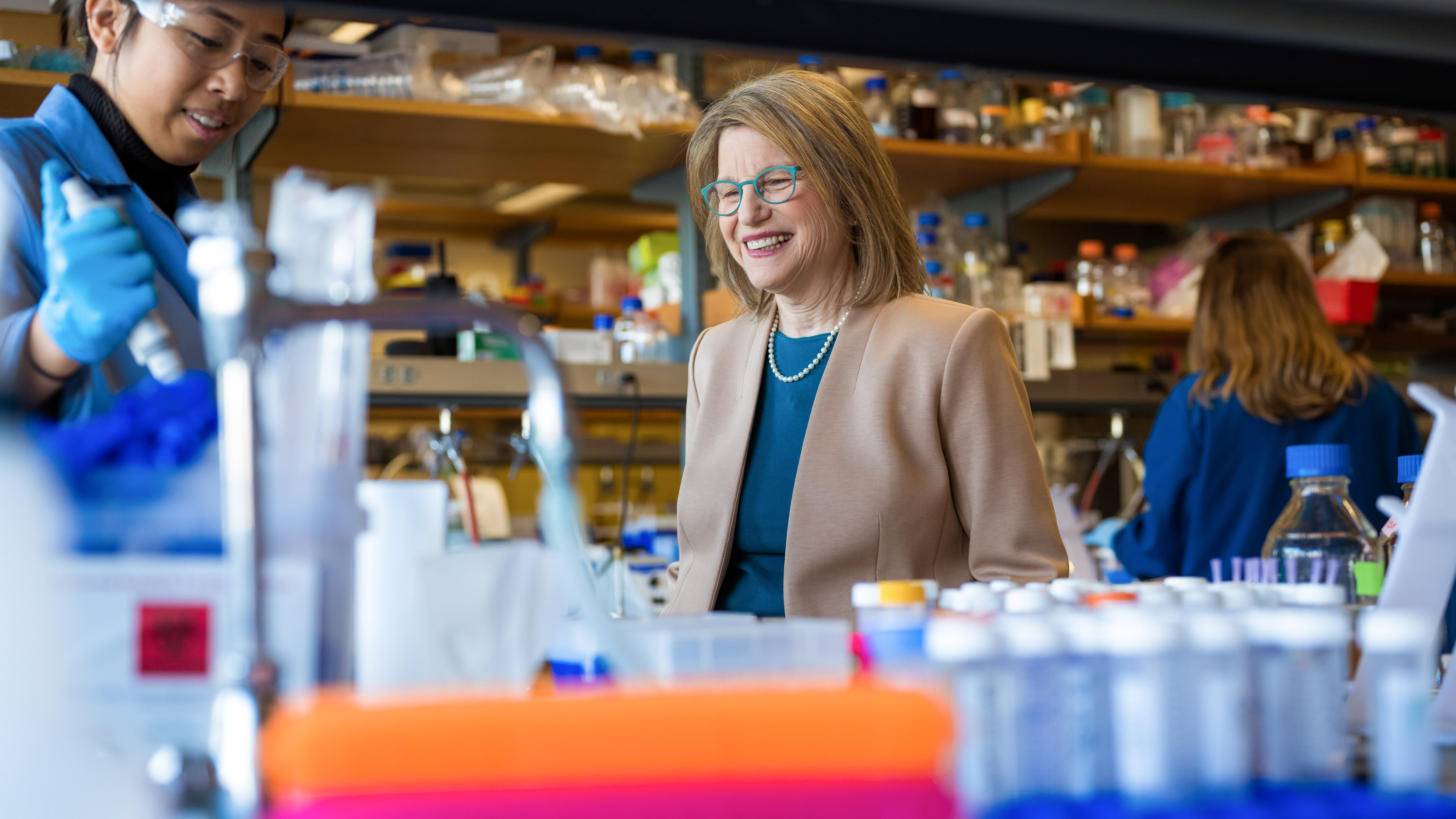
In the fall of 2019, Duke University students passing through the residential quads after 8 p.m. might not have realized they were witnessing a curious sight: provost Sally Kornbluth, the school’s second-highest-ranking administrator, hurrying by in jeans and a Duke sweatshirt on her way to an undergraduate dorm. “They have no idea who I am,” she would say with a laugh to Gary Bennett, then the vice provost for undergraduate education. “They don’t know what a provost is.” Once there, Kornbluth would invite students to play games and talk about their residential experience at Duke. “Sometimes we’d be there for hours,” Bennett remembers. “Sally would tell these amazing stories about her own time in college and her trajectory, and for a lot of our students it would be pretty inspirational.”
Mostly, Kornbluth listened. The university was rethinking its residence system, and she wanted to know what students valued and what they’d improve about their current living environment. So every few weeks that fall, she visited a different dorm to chat with students, getting input that helped her zero in on how best to improve the residential experience. “I’d never seen a provost do this,” says Bennett.
The late-night visits epitomize the leadership style of Kornbluth, who took the helm of MIT this January as its 18th president. During her time at Duke, colleagues say, she displayed an extraordinary amount of humility, approaching situations with a desire to listen and learn. When it came time to act, however, she did so decisively.
A renowned biologist and cancer researcher, Kornbluth spearheaded multiple major initiatives in her eight years as Duke’s provost. She oversaw a push to dramatically expand the sciences for a university that had been historically better known for humanities and social sciences. She led an effective effort to recruit a more diverse faculty. She helped steer a response to the covid-19 pandemic that was one of the most successful in the nation. And she and her team completely revamped the university’s housing allocation process.
On the basis of what she’d heard directly from students, Kornbluth wanted Duke to do a better job mitigating their stress and helping them build community and engage with faculty. Traditionally, students who successfully rushed a fraternity, sorority, or “selective living group” at the end of their first year got access to the best housing on campus—a decades-old system that tended to homogenize residences and leave less privileged students with the least desirable dorms. Ultimately, Kornbluth, Bennett, and the vice president for student affairs led the development of a new system for assigning housing as students move out of the dorms reserved for first-years. Dubbed QuadEx, the new system gives all students the opportunity to transfer as sophomores to the upper-class dorms along with their first-year cohort, creating a more diverse, inclusive environment. (Students can still go Greek or join selective clubs as sophomores, but Duke no longer offers housing to those groups.) QuadEx also builds community by bringing faculty into the residences as fellows and through new traditions and programming designed to help students through important transitions. And despite concerns that alums invested in halcyon memories of the former housing system would be upset, Kornbluth touted the QuadEx system proudly and helped focus fundraising efforts to support it.
As Duke’s provost, Kornbluth proved herself to be the ultimate team player, shepherding all these efforts in a way that expanded the university’s capacity for collaboration.
“She is authentic to the core, down to earth, with zero pretense—zero,” says Valerie Sheares Ashby, former dean of Duke’s Trinity College of Arts and Sciences and now president of the University of Maryland, Baltimore County. “She’s thoughtful, doesn’t take herself too seriously, and has a great sense of humor.”
Kornbluth is “one of the quickest people I have seen in terms of being able to respond in the moment to criticisms and concerns,” says Jennifer Francis, Duke’s former executive vice provost, who is now interim provost. “She won’t rise to bait, but she’ll come back with a reasoned and calm response that isn’t just one point, it’s five points. It’s quite amazing to watch.”
From poli sci to bio
A native of suburban Fair Lawn, New Jersey, Kornbluth was attracted to political science in high school and pursued the subject at Williams College. Sitting now in her office overlooking Killian Court in MIT’s Building 3, she remembers walking through the science quad at Williams as a first-year tour guide and saying, “I’m sure this is lovely, but I’m never taking a class here.” But Williams had a science distribution requirement, so she took a biology class taught by Professor Bill DeWitt, who inspired her with his historical perspective. “He was really explaining how we arrived at what we know,” says Kornbluth, who was drawn to the elegance of the experiments behind our current knowledge of biological processes. “It was almost like this intellectual puzzle,” she says.
Though she majored in political science, she continued to take classes in biology. Upon graduating in 1982, she won a scholarship to Cambridge University, where she got a second bachelor’s degree, in genetics. After earning a PhD in biology at the Rockefeller University in New York City in 1989 and completing a postdoc at the University of California, San Diego (UCSD), she joined Duke’s faculty in 1994 as a cancer biologist.
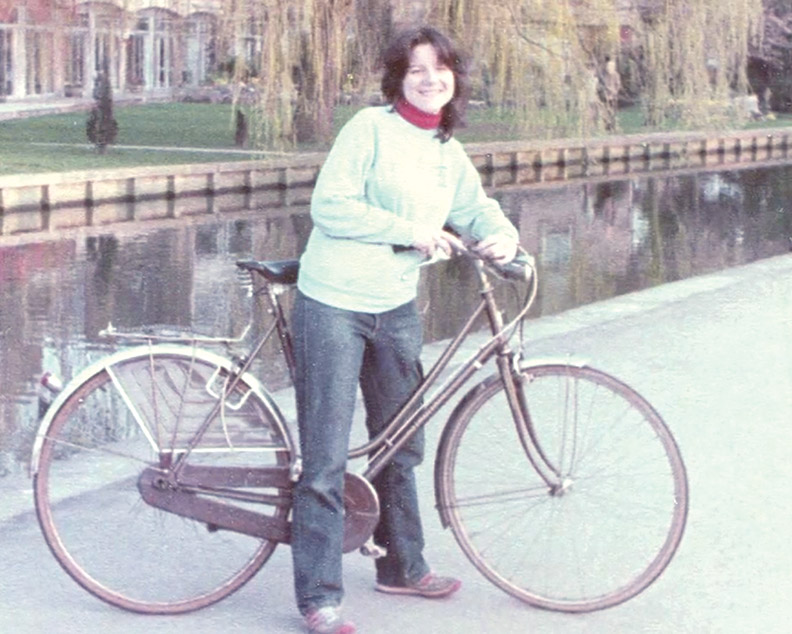
As Kornbluth set up her research lab at the Duke University School of Medicine, she planned to concentrate on studying cell proliferation. But then her first graduate student called her over to a microscope to look at a strange phenomenon. “‘I know exactly what this is!’” she recalls exclaiming. “It was a part of a cell death process that had been induced in a way that we weren’t anticipating.” That discovery opened up a new track of research: investigating apoptosis, or the natural death of cells in an organism, an area of inquiry that would end up accounting for about three-quarters of her lab’s work. She and her group eventually explored the signaling pathways that cause a cell to either start dividing or die—basic science that informs our understanding of cancer and neurodegenerative disorders such as Alzheimer’s and Parkinson’s.
Among many other findings, Kornbluth’s lab showed that caspase 2, an enzyme known to play a role in apoptosis, is regulated by the metabolic state of the cell—a surprising result suggesting that exhaustion of nutrients may contribute to cell death in oocytes, or immature egg cells. The lab also characterized how key cell cycle regulators, cyclin B and Cdc25, are controlled and did landmark studies that revealed how vertebrate cells control the on-off switch for cell division. Kornbluth’s group also demonstrated signaling pathways of cell proliferation and death in fruit flies, mice, and human cell culture.
The implications of Kornbluth’s research are far-reaching, shedding light on how cancer cells accelerate proliferation and evade apoptosis, what role metabolism plays in controlling cell death, and how apoptosis regulates the duration of female fertility in vertebrates.
“As a scientist, Sally is endlessly curious and inquisitive,” says Chris Freel, her former lab manager, now associate vice president for research and innovation at Duke. “She was fearless in giving students and postdocs freedom to be really creative and take risks.” At the same time, he says, Kornbluth was an astute judge of character, quickly identifying which students would thrive in the creative lab environment. He adds, “I’ve always been in awe of that trait, which has allowed her to build great, diverse teams.”
A broader view
Practical—even selfish—considerations prompted Kornbluth’s initial foray into an administrative role. “People go into leadership not always for totally altruistic reasons, and part of it honestly was that at the time I thought the core research facilities at Duke really needed work,” she says. “I also thought the graduate programs could be stronger.” When the position of vice dean for basic science at the medical school opened up in 2006, Kornbluth applied and got the job. To fill a need she’d seen in her own lab, the first thing she did was hire a head of proteomics—a new position that benefited other labs as well. But her focus quickly expanded to the health of the institution. “I just really wound up liking it,” she says. “I knew I could do a lot to benefit not just my laboratory, but the whole of the medical school, and even the broader university.”
When the economic downturn hit in 2008, she helped institute a program of small-dollar grants for faculty to use technologies they couldn’t host in their own labs. “It basically kept things running and opened up new areas in spite of very limited funding,” says Nancy Andrews, former medical school dean and now chief scientific officer of Boston Children’s Hospital. Kornbluth also helped to broker “partnership hires” of faculty with joint appointments in several departments. “It had the benefit of bringing in outstanding scientists, but also had the benefit of bringing departments and centers and institutes together in new ways,” Andrews says.
“As a scientist, Sally is endlessly curious and inquisitive. She was fearless in giving students and postdocs freedom to be really creative and take risks.”
Chris Freel, Kornbluth's former lab manager
In 2014, Kornbluth took on the role of provost, becoming Duke’s number-two administrator behind the president. Overnight, she went from overseeing basic sciences, something she knew a lot about, to overseeing all academic programs at Duke—which includes not only a college of arts and sciences but also an engineering school, a divinity school, a law school, a business school, and schools of public policy and the environment. So she began scheduling appointments across campus to listen and learn as much as she could. “I’ve learned you have to put in the time up front to have this intense learning experience before you try to make any decisions or plans,” she says.
One of the things Kornbluth heard over and over from students and faculty alike was a concern over lack of diversity on the faculty, which was majority white and, in STEM fields, majority male. She made fixing that a priority, creating a new office of faculty advancement in 2017 and charging it with hiring for “inclusive excellence.” “We work with search committees to make sure we tap into a broad pool of candidates,” says Abbas Benmamoun, vice provost in charge of the office. “It’s not about determining outcomes—it’s more about making sure we look at all the dossiers thoroughly and fairly, and then have the best candidates.”
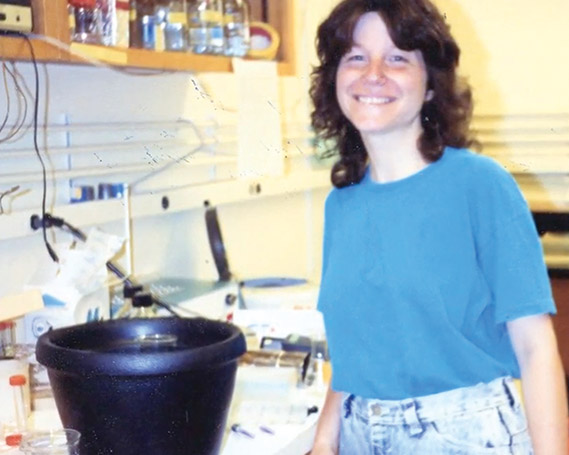
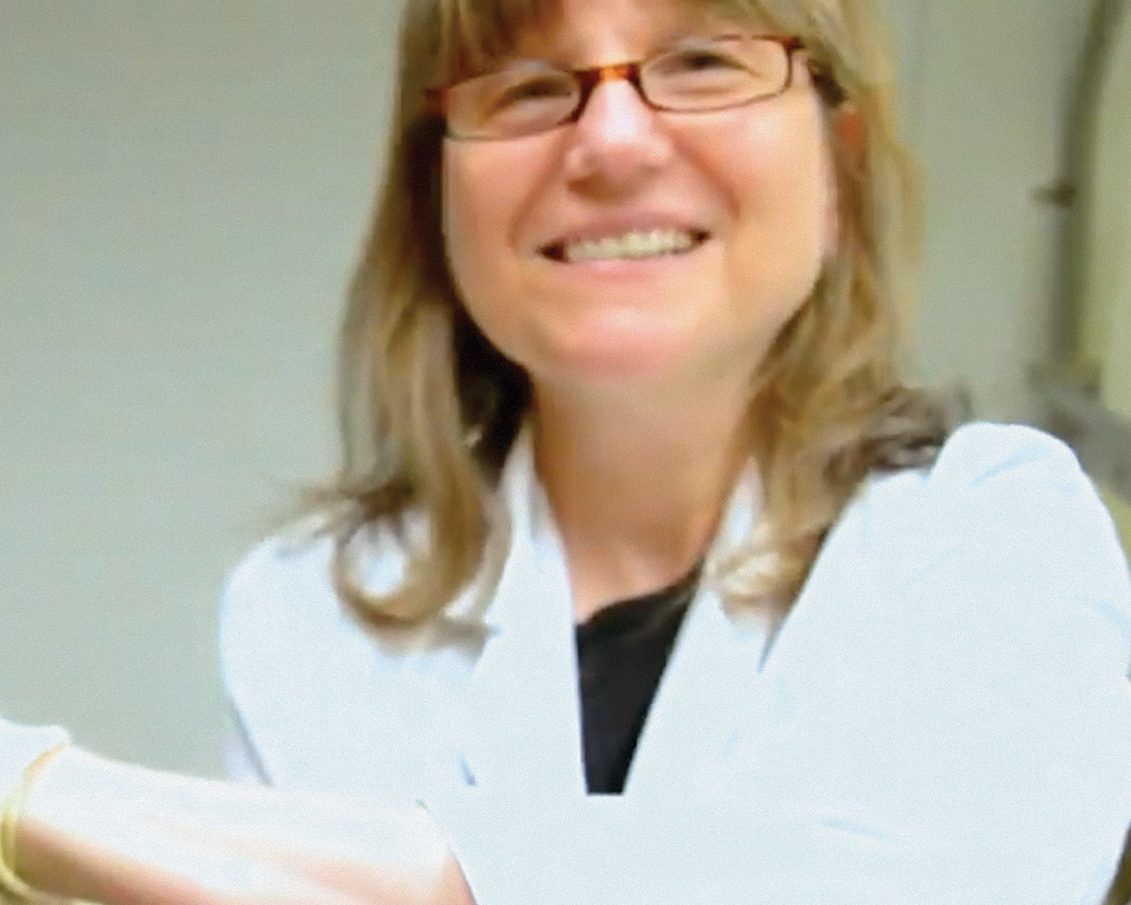
Under Kornbluth’s guidance, the office expanded outreach for hiring. It contacted conferences and professional organizations with more diverse memberships, helped search committees write more inclusive job descriptions to attract a broader pool of candidates, and created standards for evaluating application packages to mitigate bias and ensure fairness and rigor. Rather than relying on a subjective evaluation of the candidate, Benmamoun says, “we developed rubrics for search committees to use: Is your decision based on reading their CV, engaging with their scholarship, attending their job talk?” The initiative bore fruit: the number of faculty members from underrepresented minority groups increased by more than 50% during Kornbluth’s tenure as provost, and the number of women increased by more than 30%. Sheares Ashby notes that the hires didn’t just check demographic boxes but also helped build new departments in African, Asian-American, and Latino/a studies. “So we were simultaneously able to diversify the faculty and the departments,” she says. Meanwhile, all faculty were offered coaching and workshops on such topics as mentoring and teaching in a diverse classroom.
Beyond those efforts, Kornbluth also focused on faculty retention and creating an environment where a more diverse faculty would feel supported and welcome. One successful initiative, says Benmamoun, invited faculty to propose their own programs and provided seed grants to fund promising faculty-development and community-building proposals. A group of Black faculty, for example, proposed a writing group to help support a scholarly community, with peer-to-peer mentoring and regular retreats. “That is something I went to Sally with, and we found the resources for it, and now it is one of the most successful programs we have here at Duke,” Benmamoun says.
The power of teams
Just as Kornbluth assembled productive groups of researchers in the lab, her real skill as a leader is putting together effective administrative teams, colleagues say. “Sally has this eye for talent and finding the right people,” says Benmamoun. Bennett agrees: “Her superpower is building a team of people who enjoy being around each other. There is a kind of community-building thing that she just does natively that really helps in those moments where you have to make hard decisions.”
According to Kornbluth, that “superpower” goes beyond just finding the most qualified person for a job—it’s also important that they mesh well with existing team members. “I always say it’s just as easy to hire nice, kind, collegial people as it is to hire not-nice people,” she says. “A big thing was identifying people who were super talented and really wanted to collaborate.”
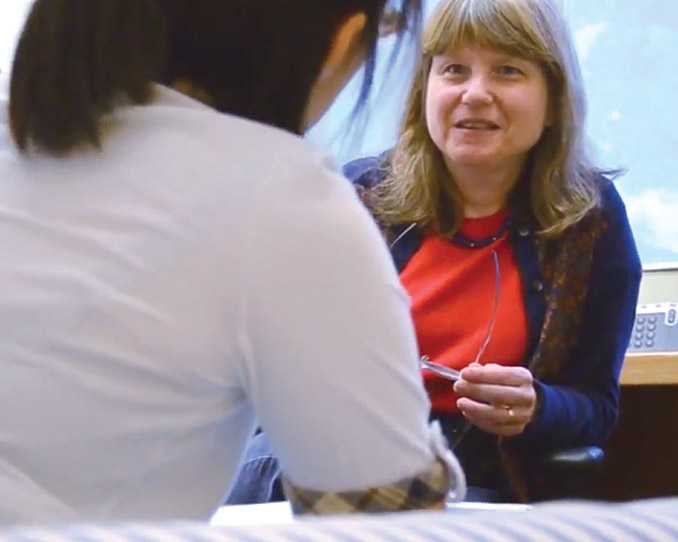
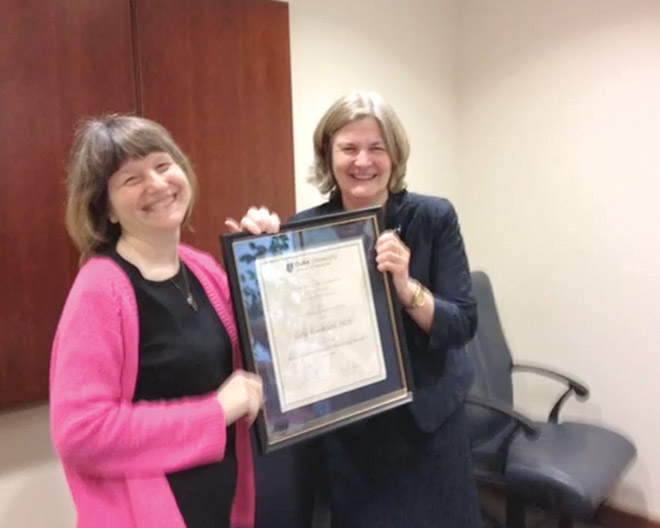
Her former coworkers say that characterization described her as well. “She was always smiling, even through difficult situations—always saying, ‘We’re going to figure this out,’” says Hallie Knuffman, who served as her chief of staff. Kornbluth was the kind of boss who stopped work to celebrate colleagues’ birthdays, gave out mugs saying “Best Team Ever,” and kept a bowl of Sour Patch Kids and Smarties on her desk to share with visitors. (Kornbluth, a type 1 diabetic, says she favors Smarties because they are the “fastest-digesting sugar.” And she doesn’t shy away from talking about her condition, because she wants newly diagnosed people to know it’s manageable.) “She is one person I can say is truly kind,” says her former executive assistant Mary Greenway, who regularly texted with Kornbluth about their mutual love for British mysteries. “And she has way more patience for people than I do.”
Kornbluth needed those qualities during the covid-19 pandemic, when—like many university leaders—she had to make quick but difficult decisions about campus safety. She relied on her science background to assess risks, consulting the medical school’s experts on viruses and vaccines. “I’ve never been so grateful to have a provost who was from the school of medicine,” says Francis. “Sally picked up that testing was going to be key.” While the campus closed in the spring of 2020, Duke was one of the few to reopen to residential students that fall, buttressed by a massive pooled testing regimen and a contact-tracing app developed specifically for Duke that enabled quick quarantining.
“She was evidence driven the entire time,” says Bennett. “She came to the meetings and had read all of these papers. She was pushing us to a practical protocol, modeling what we should be doing in a research institution, which is building consensus around evidence-based conclusions.” Given the success of its response, Duke was held up (along with MIT) as a national model for how campuses could manage the pandemic.
Not that there weren’t sometimes conflicts. In the spring of 2021, the administration canceled spring break—it was simply too risky to have students leave campus and return. But students, exhausted by months of mask wearing and social distancing, protested. Student government member Shrey Majmudar wrote to Kornbluth, telling her students desperately needed a mental-health break. “At first we were at odds,” he says. “It’s hard to go back on a decision you’ve made.”
But in a Zoom meeting, Kornbluth approached the issue with an open mind. “We brainstormed together,” Majmudar says. Kornbluth pushed through changes to the academic calendar at the last minute to give students two mental-health days, which they were asked to take without leaving campus. She even worked with student government to plan student activities such as meditation and distanced yoga. “It’s a testament to Sally’s creativity, her humility, and her ability to balance stakeholders,” Majmudar says. “The undergraduates were so thankful to have the break.”
Ready to listen
The creative thinking and openness to compromise that she showed on the spring break issue were typical of Kornbluth, say those who know her. “She has strong opinions, weakly held,” says Bennett. “None of us feared pushing back on her—she’d walk into a meeting telling you exactly what she thinks, but she could also be moved by evidence.” Even during the pandemic, Kornbluth didn’t lose sight of other important initiatives. Duke Science and Technology, for example, was an effort to encourage collaborations to tackle global challenges that led to hiring more than 20 new faculty members in areas including artificial intelligence, biological resilience, and materials science.
“Her superpower is building a team of people who enjoy being around each other. There is a kind of community-building thing that she just does natively that really helps in those moments where you have to make hard decisions.”
Gary Bennett, former vice provost for undergraduate education at Duke University
Kornbluth’s Duke colleagues point to her efforts to foster collaboration and inclusiveness as her greatest legacy at the university. “All large research institutions are siloed by their very nature,” Bennett says. “There’s a way of leading that reinforces silos if you value leaders based on their individual accomplishments.” Instead, he says, Kornbluth always emphasized the success of the team or the institution.
Indeed, Kornbluth seemed driven to make connections between different groups on campus with initiative after initiative—QuadEx to break down student cliques in housing; MEDx to make joint appointments between the medical and engineering schools; Collaboratories, a program to fund faculty research crossing disciplinary lines; and the Provost’s Forum, a campus-wide event to take on difficult topics such as free speech or immigration from multiple perspectives.
As it happens, the issue of free speech would come to the fore at MIT soon after her arrival as flyers expressing hatred toward the LGBTQ community and other underrepresented groups appeared across campus—a deliberate provocation by students to test a new faculty statement on freedom of expression. Kornbluth ultimately denounced the action in a video to the MIT community, in which she also decried the recent defacement of posters put up by the Black Students’ Union: “I see a clear distinction between what we can say to each other—in other words, what we have a right to say—and what we should say to each other as decent human beings living together in a community.” As MIT tackles thorny issues like freedom of expression and harassment, she continued, “I want us to be engaged in a robust discussion without going to the extremes of provoking each other.” A few weeks later, Kornbluth would introduce the first speaker, Heterodox Academy president John Tomasi, in a long-planned new lecture series called “Dialogues Across Difference: Building Community at MIT.”
Kornbluth’s commitment to community building and open communication at the Institute was also evident at her first faculty meeting in February, when she spoke about her job as one of lowering barriers for MIT researchers, helping secure the resources MIT needs to fulfill its mission, and creating cohesion. She also shared her direct email address with the faculty (“I’d rather see the train at the corner than when it’s at the office door,” she told them).
Learning about MIT
True to form, as soon as Kornbluth arrived on campus, she embarked upon a listening tour to better understand how she can shape the future of the Institute. She quickly learned that MIT is interdisciplinary at its core, priding itself on its literal and figurative lack of walls between departments. But that can also have downsides.
In early April, Kornbluth shared with faculty, students, and staff a draft made up of comments she’d been hearing in her MIT listening tour, and many pointed to a lack of Institute-wide cohesion. “‘Let a thousand flowers bloom’ doesn’t work for climate change; we need some sort of organizing principle,” said one faculty member. “Decentralization is great—it allows departments to put their own spin on things—but we need better communication and a baseline of consistency,” said a member of the staff.
As her inauguration in May approached, Kornbluth was still taking it all in. “MIT is extremely decentralized, and that has its pluses and minuses,” she says. “It really does allow a lot of innovation and entrepreneurship. But it’s hard to think about how you elevate the Institute-wide initiatives.”
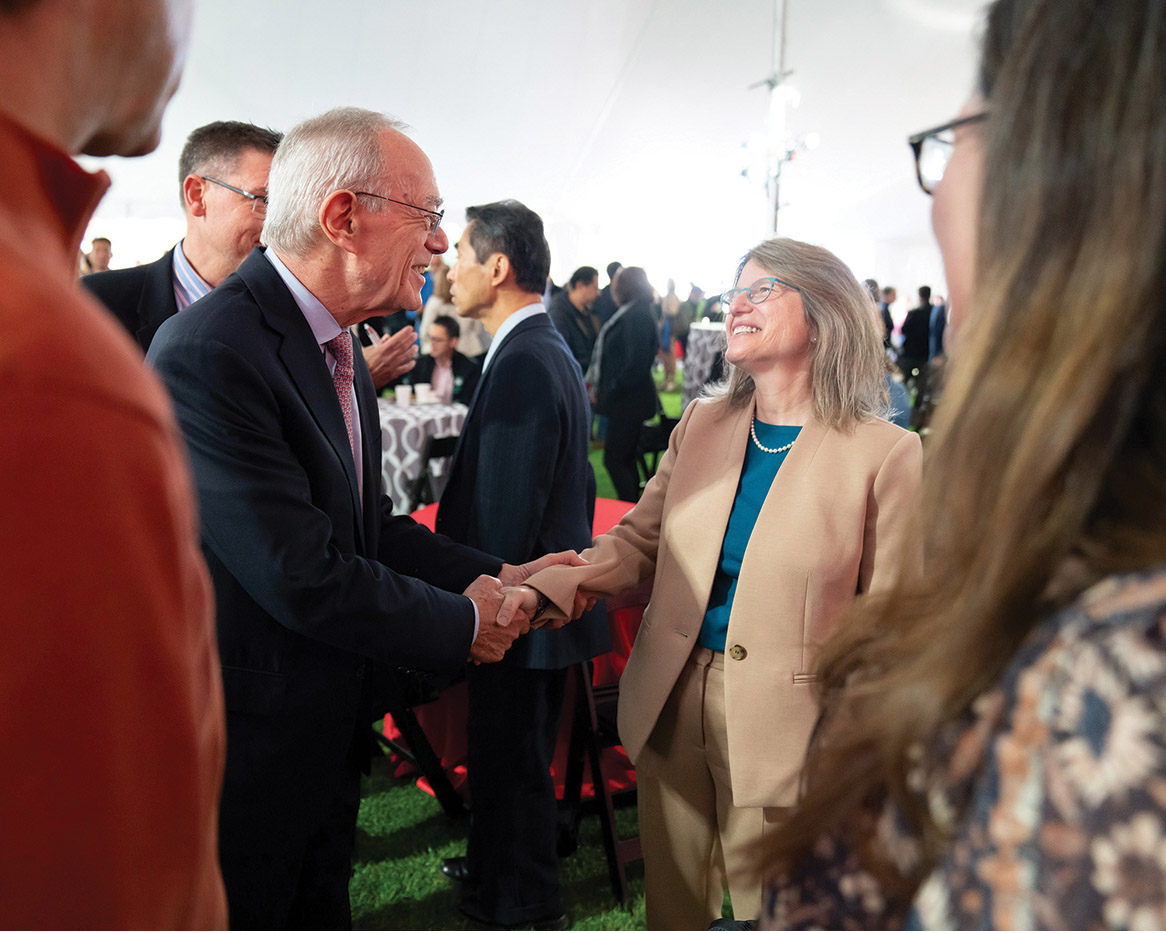
Those comments, however, are only just a few in a multitude—almost a cacophony—of comments on a wide range of topics including research and academic priorities, diversity, free speech, AI, rethinking the General Institute Requirements, unionization, hierarchy, housing, online learning, and mental health. So Kornbluth has her work cut out for her.
As she settles into her new role, she is taking the time she needs to understand the Institute. Her listening tour will continue through the fall to give her a broad sense of the MIT community’s hopes, concerns, and dreams. If one thing is clear from her track record, it’s that Kornbluth will listen hard. Then she will act.
In her inaugural address, she identified three key things university leaders are good for. They can “provision the trip” with the right resources and the right talent, she said, and “clear away bureaucratic boulders that block the trail.” And they can “scout out the best routes for scaling the toughest peaks—and build and inspire the right teams to get there.”
“If we do those three things right,” Kornbluth said, “we create an environment in which every individual has the freedom and support to flourish and grow, and in which we all have a sense of community, connection, and shared purpose—those human bonds that allow us to go farther and faster together than any of us could go alone.”
Keep Reading
Most Popular
How scientists traced a mysterious covid case back to six toilets
When wastewater surveillance turns into a hunt for a single infected individual, the ethics get tricky.
The problem with plug-in hybrids? Their drivers.
Plug-in hybrids are often sold as a transition to EVs, but new data from Europe shows we’re still underestimating the emissions they produce.
What’s next for generative video
OpenAI's Sora has raised the bar for AI moviemaking. Here are four things to bear in mind as we wrap our heads around what's coming.
Stay connected
Get the latest updates from
MIT Technology Review
Discover special offers, top stories, upcoming events, and more.